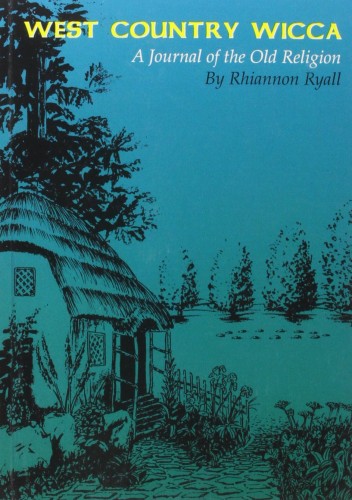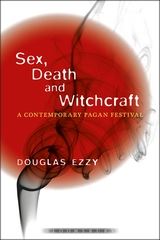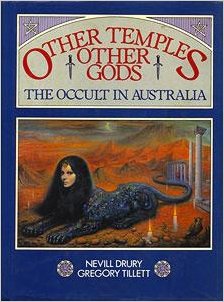I’m not a historian and I don’t play one on the Internet. I do think it’s good to have some knowledge and understanding of the history and development of our religious traditions, as mysterious, complex, and convoluted as they are.
There’s an increasing number of material available around the history and development of historic and contemporary Paganism and Witchcraft in Europe and the U.S. Ronald Hutton and Margot Adler, for example, have given us valuable scholarly insight.
We don’t hear very much about Australia, and I wasn’t sure where to start looking. Thankfully, a few Aussie friends have pointed me in the right direction, sharing some fascinating stories that highlight a few of Australia’s most important and colourful characters.
![[Courtesy Tasmanian Pagan Alliance]](https://wildhunt.org/wp-content/uploads/2015/05/tasmanian-pagan-alliance-stall-at-affbr-500x281.jpg)
[Courtesy Tasmanian Pagan Alliance]
Rosaleen Norton (2 October 1917 – 5 December 1979) may be Australia’s most famous Witch. Norton scandalised conservative Australia during the 1940s and 50s. Her art, which contained supernatural and sexual themes, was treated harshly. Police removed her work from exhibitions, confiscated books that contained her images, and attempted to prosecute her for obscenity. She was arrested countless times.
When Witchcraft was still illegal in Australia, Norton openly declared herself a Witch and a Pagan. She was an occultist devoted to Pan and led a coven in the bohemian area of Kings Cross in Sydney, where she lived. She was often at the centre of police and tabloid scrutiny.
Norton died in 1979 from colon cancer. Interest in her life and her work hasn’t waned. A number of books about Norton have been published over the years. Most recently, Sonia Bible has written and directed a new documentary called The Witch of Kings Cross. Norton remains a key influence in Australia’s Pagan landscape. For more on Norton, read the two-part Wild Hunt series published last month.
 Rhiannon Ryall is the pseudonym of an English-born Australian Wiccan who established a coven-based tradition in Australia. Ryall asserted that, at the age of 16, she and other youth in her village were initiated into a local, pre-Gardnerian, Wiccan tradition in West Country, England during the 1940s. However, as I’ve been told, historians and Aussie Witches are skeptical of her Ryall’s assertion. Her tradition appears to be a blend of Gardnerian and Alexandrian practices.
Rhiannon Ryall is the pseudonym of an English-born Australian Wiccan who established a coven-based tradition in Australia. Ryall asserted that, at the age of 16, she and other youth in her village were initiated into a local, pre-Gardnerian, Wiccan tradition in West Country, England during the 1940s. However, as I’ve been told, historians and Aussie Witches are skeptical of her Ryall’s assertion. Her tradition appears to be a blend of Gardnerian and Alexandrian practices.
Ryall published a number of books, but her most important and best known work is West Country Wicca: A Journal of the Old Religion. Like Norton, she was no stranger to the media. After the unexpected death of her daughter in 1991, Ryall and her husband abducted their granddaughter. The saga lasted for years, and the couple, already in their sixties, served some jail time. It garnered media attention and public praise for the father, the man who rescued his daughter from the Devil-worshiping witches. The event inspired a made-for-television movie in 1999.
I don’t know when Ryall passed away. Despite having been known as “a bit of a fibber,” and her legacy being tarnished by the kidnapping, Ryall was involved in several traditions and left behind a number of students and initiates. I’m told she was a lovely woman who is missed by many.
Simon Goodman (16 September 1951 – 23 September 1991) may be one of the most enigmatic figures in Australia’s magickal landscape. It’s hard to separate the facts from mythic history, but it’s safe to say that Goodman was the main promoter and initiator of Wicca in Australia in the late 1970s and 1980s.
It appears Goodman was initiated into Alexandrian Wicca in Sussex. He met and corresponded with Alex and Maxine Sanders, who gave him their blessing and a charter to initiate others. Goodman made good use of the photocopier at his workplace, copying entire books for his network of covens across Australia. When he died, he left his collection of documents to Murdoch University. According to Douglas Ezzy, in his essay “Australian Paganisms,” Alexandrian Wicca is the most numerous initiate tradition in Australia mostly deriving from individuals who trained with Goodman.
The Scholars and Storytellers
 Douglas Ezzy is an Associate Professor of Sociology at the University of Tasmania. His contribution is mainly academic with a number of studies and essays appearing in other works aside from his own books. His work includes Sex, Death and Witchcraft: A Contemporary Pagan Festival, a look at one of Australia’s more well-known and controversial festivals, Faunalia.
Douglas Ezzy is an Associate Professor of Sociology at the University of Tasmania. His contribution is mainly academic with a number of studies and essays appearing in other works aside from his own books. His work includes Sex, Death and Witchcraft: A Contemporary Pagan Festival, a look at one of Australia’s more well-known and controversial festivals, Faunalia.
Lynne Hume is a University of Queensland anthropologist who published the first and major defining academic study of Australian Paganism. Unfortunately, Witchcraft and Paganism in Australia is out of print, but can sometimes be found from second-hand book dealers.
 Nevill Drury (1 October 1947 – 15 October 2013) was an English-born Australian editor, publisher, and author of over 40 books on subjects ranging from shamanism and western magical traditions to art, music, and anthropology. He has many titles worth exploring, but one book of special interest here is Other temples, Other Gods: The Occult in Australia, which is also out of print. He is also the author of “The Magical Cosmology of Rosaleen Norton,” published in Pomegranate: The International Journal of Pagan Studies in 2010.
Nevill Drury (1 October 1947 – 15 October 2013) was an English-born Australian editor, publisher, and author of over 40 books on subjects ranging from shamanism and western magical traditions to art, music, and anthropology. He has many titles worth exploring, but one book of special interest here is Other temples, Other Gods: The Occult in Australia, which is also out of print. He is also the author of “The Magical Cosmology of Rosaleen Norton,” published in Pomegranate: The International Journal of Pagan Studies in 2010.
Peregrin Wildoak is the blogger behind Magic of the Ordinary. He is doing important work cataloguing material that Simon Goodman left behind, as well as recording memories and wisdom from Perth Wiccan elders from the 1970s and onward. His work will be invaluable to those collecting the history of Paganism and Witchcraft in Australia.
Brittany McCowan is a young aspiring documentary filmmaker from Lennox Head, Australia. She is currently working on directing her first feature length documentary called Modern Witches and Paganism in Australia. You can read my interview with McCowan on my blog and find out more about this project by visiting her website or her GoFundMe page.
Australia does have a story to tell. It has people worth knowing, and a history worth recording for future Pagans and Witches.
The Wild Hunt is not responsible for links to external content.
To join a conversation on this post:
Visit our The Wild Hunt subreddit! Point your favorite browser to https://www.reddit.com/r/The_Wild_Hunt_News/, then click “JOIN”. Make sure to click the bell, too, to be notified of new articles posted to our subreddit.
Another contemporary figure is Julia Phillips, who brought the Pagan Alliance to Australia. A bit about her can be read here: http://taspainc.com/alliancehistory.php#julia
Thanks, Terri! I’m always looking to learn more and appreciate any new info that comes my way.
The trouble with Rhiannon Ryall is, her pleasant little fiction of country life in a village of all pagans — in the 1940s — runs headlong into the fact that she completely ignores WORLD WAR TWO.
It has been suggested by an elder of my acquaintance that a great deal of “West Country Wicca” is cribbed wholesale from from a late 19th Century book on West Country folk practices, possibly this one:
https://archive.org/details/everydaybookorgu01hone
From the skimming I’ve done, it seems highly likely. That being the case, it seems more like a work of fiction containing some filtered facts that might be of use. Or, one could just download the older book and read THAT instead, without all the bullshit.
She’s definitely an intriguing and controversial figure.
I actually find her a repellent and controversial figure. It’s disturbing to keep learning about the lack of integrity of so many Neo-pagan forebears.
That was interesting, thank you!
Where’s Fiona Horne?
Nevil Drury was a treasure. His history books are a breeze to read and full of great information. He is very much missed.
One aspect I am sorry to see not included in this piece is a rundown of the festivals that have secured themselves a place in the history of contemporary witchcraft in Australia, although I am glad Doug’s book got a mention.
From the Mt Franklin Beltane festival (the longest-running in the Southern Hemisphere, 34 years this year), to the Australian Wiccan Conference, to the Pagan Summer Gathering, to the Eostre gatherings of the 90s, to the pseudonymous (and yes, controversial) ‘Faunalia’ festival in the 2000s, the on-again-off-again Magick Happens events in Sydney and Melbourne, the entry of the Reclaiming Tradition into the scene with its “Witch Camps” and other smaller events.
I’d argue these festivals, the people who’ve attended them, and the rituals that have taken place at them represent a more democratic sampling of the Australian scene over the past 40 years.
Thanks for that great feedback, Gavin. Festivals are essential to the developing and sharing Pagan culture. I consider this a work in progress so their lack of inclusion here isn’t intended to diminish their importance. It’s just an area I haven’t delved that deeply into yet.
Hi there. Wonderful article, thanks.
I would definitely second the importance of Julia Philips. She influenced the shape of Australian Wiccan and Paganism tremendously with the founding of the then Pan Pacific Alliance, linking to Pagan Federation in Britain. She also fostered ties between Australian and New Zealand groups and encouraged Simon Goodman to share his story before his untimely death in the now infamous ‘Cockroach Papers’. Privately she shared much information and provided links between Australians and authentic groups in the UK.
I would just like to point out the lovely fact that two of the big name you mention, Simon and Rhiannon, both came from Perth, the most isolated (back in the 70s) city in the world, but the major centre Wicca in Australia.
Elder Wiccans and occultists in Perth remember Rhiannon with fondness despite her fibbing and it should be pointed out she was involved in other occult activities besides Wicca. This included a Golden Dawn order, and being the stalwart Tarot reader for the Magic Circle Bookshop in Perth for many years. This shop was THE go to place for Wiccan contacts and material for ages, and its owner, David, in his own way deserves credit for being influential on our community also. Now retired from the community and in his 70s I had the pleasure of sharing a circle with him recently and he remains a vital force.
I am humbled and way out of my depth to be included on a list with Nevill, Lynne and Douglas. Nevill, to his was helping me with my research and he will be sorely missed by both the esoteric and art communities in Australia. I would point out Nevill’s co-author on Other Temples, Other Gods, the Rev. Dr Gregory Tillett broke ground in the early 1970s producing the first Australian academic research on the occult.
Thanks for including Brittany on the list: I encourage everyone to support her important project with hard dollars.
Finally, just a call out I do whenever I can: as I have mentioned previously I have found no evidence that Simon Goodman’s putative Sussex Craft teacher, a Mr Paul Morley existed, but I still am not prepared to dismiss the possibility completely. If anyone has evidence to the contrary I invite them to comment here or contact me privately. THANKS 🙂
A great read here – thank you! I have heard of an Australian group of folk under the name ‘Oz’ – I remember a video about (them/it) highlighting a ritual…this was back in the late 80’s(?) Does any of this ring true or am I mistaken?